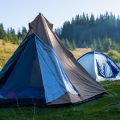1. Choosing the Right Campsite
When youre gearing up for stormy conditions and high winds, picking the right campsite is your first line of defense. The spot you choose can make a huge difference in how well your tent holds up. Here are some practical tips to help you find a location that naturally shields you from harsh weather.
Look for Natural Windbreaks
Trees, bushes, large rocks, or even small hills can all act as windbreaks. Setting up your tent behind these natural barriers can reduce the impact of strong gusts. Just make sure to check for dead branches or unstable rocks overhead that could fall during a storm.
Comparison Table: Good vs. Bad Campsite Features
| Feature | Good Choice | Bad Choice |
|---|---|---|
| Wind Exposure | Behind trees, shrubs, or boulders | On open hilltops or ridges |
| Flood Risk | Gentle slope for drainage, higher ground | Low-lying areas or dry creek beds |
| Debris Risk | No overhanging branches or loose rocks above | Beneath dead trees or unstable cliffs |
| Ground Surface | Flat, firm ground (not too rocky) | Muddy, loose, or sloped terrain |
Avoid High and Exposed Areas
Campsites on ridgelines or hilltops may offer great views, but theyre also where wind hits hardest. Stick to lower elevations or areas tucked away from the prevailing wind direction whenever possible.
Pay Attention to Water Flow
If it rains hard, water will flow downhill and collect in low spots. Choose a site on slightly elevated ground with good drainage so your tent doesnt turn into a puddle.
Quick Tips for Picking Your Campsite:
- Walk around before setting up—look for signs of previous flooding or fallen branches.
- Test the wind direction with a simple trick: toss a handful of grass into the air and watch which way it blows.
- If camping in an established campground, use provided wind shelters like fences or hedges.
- Avoid camping right next to rivers or lakes if heavy rain is possible—the water level can rise fast.
2. Upgrading Tent Stakes and Guy Lines
If you want your tent to stay put during a storm, the stakes and guy lines you use make a huge difference. Most tents come with basic aluminum or plastic stakes and thin cords. These might work for calm summer nights, but in stormy conditions and high winds, they often aren’t enough. Here’s how you can upgrade these critical components for extra holding power.
Why Standard Stakes and Guy Lines Fall Short
Standard tent stakes are usually lightweight and small so they’re easy to pack, but that also makes them easier to pull out of loose or wet ground when the wind picks up. The same goes for basic guy lines—they can snap, stretch, or slip under pressure.
Choosing Better Tent Stakes
Look for stakes made from stronger materials like steel or heavy-duty aluminum. The shape matters too—Y-shaped or V-shaped stakes offer more grip than straight ones, especially in soft or sandy soil. For rocky or frozen ground, nail-style stakes (sometimes called “spikes”) work best.
| Stake Type | Best For | Pros | Cons |
|---|---|---|---|
| Y-Stakes (Aluminum/Steel) | General use, soft soil | Excellent hold, strong | Heavier than standard stakes |
| Nail/Spike Stakes | Rocky/frozen ground | Pierce hard ground easily | May bend if forced into rocks |
| Screw-in Stakes | Sand, loose soil | Great grip in loose soils | Bulky to carry, take time to install |
| Plastic Sand/Snow Stakes | Sand or snow only | Wide surface area, light weight | Brittle in cold weather, not for hard soil |
Selecting Stronger Guy Lines
Upgrading your guy lines is just as important as swapping out your stakes. Look for reflective 3mm or 4mm paracord or specialty guy line cord designed for camping. Thicker lines are stronger and less likely to break under tension. Reflective options help you avoid tripping at night too.
Features to Look For:
- Reflectivity: Makes lines visible at night with a flashlight or headlamp.
- Tensile Strength: Rated for at least 200 lbs (90 kg) of tension.
- No-Stretch Material: Dyneema or similar fibers won’t sag when wet.
- Cord Tensioners: Make tightening and adjusting lines much easier.
Quick Comparison Table: Guy Line Options
| Cord Type | Main Benefit | Caution/Downside |
|---|---|---|
| Nylon Paracord (3-4mm) | Cheap & easy to find, good strength | Slightly stretches when wet |
| Dyneema Cord (Spectra) | No-stretch, super strong & light weight | More expensive than nylon cords |
| Braided Polypropylene Cord | No-stretch, affordable | Abrades more easily over time |
How To Replace Your Tent’s Stakes and Guy Lines:
- Remove old stakes/guy lines: Pull out all factory-supplied stakes and untie the original cords from attachment points.
- Add new guy lines: Cut lengths of upgraded cord (at least 6–8 feet long), tie securely using bowline knots or figure-eight loops to tent’s stake-out points.
- Add cord tensioners: Thread each line through an adjuster so you can tighten easily once staked out.
- Pound in new stakes: Drive sturdy new stakes at a 45-degree angle away from your tent for best holding power.
- Tension the system: Tighten guy lines until taut—but not so tight they stress your tent fabric.
This simple upgrade can make a dramatic difference in how well your shelter stands up to rough weather. In the next section, we’ll look at smart ways to position your tent and set up your rainfly for maximum storm protection.
![]()
3. Securing the Tent Properly
Step-by-Step Guide to Pitching and Reinforcing Your Tent
Setting up your tent right is crucial when you’re bracing for a storm or gusty winds. Here’s a simple, step-by-step guide to make sure your shelter stays put, even when Mother Nature throws her worst at you.
Step 1: Pick the Right Spot
- Shelter from the Wind: Look for natural windbreaks like trees, bushes, or hills. Avoid open fields and ridges where wind can hit your tent full force.
- Ground Check: Pick flat ground that isn’t in a dip where water might pool if it rains.
Step 2: Lay Out and Stake Down the Corners
- Unpack your tent and lay it out flat with the door facing away from the wind (usually downwind).
- Stake down all four corners before adding poles. This keeps your tent from blowing away as you set it up.
Step 3: Assemble and Insert Tent Poles
- Connect all pole sections fully so they’re sturdy—don’t force them if they seem stuck.
- If your tent has sleeves, slide poles through; if it uses clips, fasten them securely over each pole segment.
Step 4: Secure All Guy Lines
Guy lines are essential for stability in strong winds. Here’s a quick table to show where to attach them for maximum effect:
| Guy Line Position | Where to Attach | Why It Matters |
|---|---|---|
| Corners | Tent corners & rainfly corners | Keeps base grounded and prevents lifting |
| Sides/Midpoints | Midway along tent sides | Adds tension, reduces flapping and collapse risk |
| Top/Ridge Points | Tent top or ridge loops | Stabilizes roof against downward pressure from wind/gusts |
- Tighten guy lines evenly but don’t overtighten; too much tension can damage fabric or poles.
- If using adjustable tensioners, check them after setup to ensure everything is snug.
Step 5: Use Heavy-Duty Stakes and Double Up If Needed
- For stormy weather, swap out standard stakes for longer, thicker ones made for hard or soft ground—think MSR Groundhog or beefy steel stakes.
- If the soil is loose, use two stakes per guy line in a “V” shape for extra holding power.
Quick Reference Table: Best Stake Types by Ground Condition
| Ground Type | Recommended Stake Type |
|---|---|
| Sandy/Loose Soil | Screw-type or long sand stakes |
| Rocky Soil | Nail-style or Y-shaped metal stakes |
| Muddy/Soft Ground | Wide plastic or snow stakes (even in mud!) |
| Grass/Firm Soil | Standard aluminum or steel stakes (8-12″) |
Step 6: Final Checks After Setup
- Walk around your tent and re-tighten any loose guy lines or stakes after 10-15 minutes—they can loosen as fabric settles.
- If it’s already windy while pitching, have a friend help hold fabric and poles steady as you work.
- Avoid storing heavy gear only on one side—keep things balanced inside for extra stability.
4. Adding Extra Anchoring Techniques
When you’re camping in stormy weather or high winds, sometimes the standard tent stakes and guylines just aren’t enough. Luckily, you don’t have to rely solely on what came in your tent bag. Let’s dive into creative and practical ways you can reinforce your tent using either natural materials found at your campsite or a few extra pieces of gear you might already have.
Using Natural Materials Around Your Campsite
Nature offers plenty of resources for stabilizing your shelter when conditions get rough. Here are some easy ideas:
| Material | How to Use It |
|---|---|
| Rocks | Place large rocks over your tent stakes or directly on guylines to keep them taut and in place. |
| Sticks/Branches | Create additional stakes by sharpening sturdy sticks and driving them into the ground as backups for existing anchor points. |
| Logs | Lash logs horizontally across the base of your tent to act as windbreaks or weight down the edges of your rainfly. |
| Pine Needles/Brush | Pile brush around the base of your tent for extra insulation and minor wind buffering (just keep it away from open flames). |
Extra Gear You Can Pack for Reinforcement
If you want to be really prepared, a few simple additions to your gear list can go a long way:
- Heavy-duty Stakes: Bring longer, thicker stakes for tough ground or high winds.
- Paracord: Extra cord is endlessly useful—add more guylines or secure loose fabric.
- Tarp Clips: These let you create new anchor points wherever needed.
- Bungee Cords: Absorb shock from gusts and reduce stress on tent fabrics and poles.
- Duct Tape: Patch up tears or reinforce weak spots on the fly quickly.
Combining Techniques for Maximum Stability
The best results often come from mixing and matching these methods based on what’s available. For example, use paracord to tie a guyline from your tent to a sturdy tree, then add rocks over the line’s anchor point for extra security. Or, double up by supplementing manufacturer-provided stakes with both heavy-duty upgrades and sharpened branches if you run out of hardware.
A Quick Reference Table for On-the-Fly Reinforcement
| Situation | What To Try First | If That’s Not Enough… |
|---|---|---|
| Sandy Soil | Bury stakes sideways; use logs over stake points | Add rocks on top; use longer stakes or sticks driven deep at an angle |
| No Trees Nearby | Add extra guylines staked far out with heavy-duty stakes | Create anchors with buried bags filled with sand or dirt (“deadman” anchors) |
| Sustained High Winds | Tighten all guylines; use bungee cords for flexibility | Pile rocks/logs against the windward side; reinforce seams with duct tape if needed |
Pro Tip: Always Check Local Regulations!
If you’re gathering natural materials at a campsite, make sure it’s allowed—some parks require that you leave everything as you found it. And always respect Leave No Trace principles when reinforcing your setup with natural objects.
5. Weatherproofing the Tent
Sealing Tent Seams
Most tents come with seams that are stitched, which can let water in during a heavy downpour. One of the easiest ways to weatherproof your tent is to seal all the seams using seam sealer. Here’s how you can do it:
- Set up your tent in a dry area so you can see all the seams.
- Clean the seams with a damp cloth and let them dry completely.
- Apply a thin layer of seam sealer (make sure it’s compatible with your tent fabric) along all stitched areas, especially where the floor meets the walls and around doors and windows.
- Let the sealer dry as directed by the manufacturer before packing away your tent.
Using Additional Rain Flies or Tarps
An extra rain fly or tarp adds another level of defense against wind-driven rain. Here are some common setups:
| Method | Benefits | How To Do It |
|---|---|---|
| Extra Rain Fly | Specifically shaped for tents, offers full coverage | Drape over your tent and secure tightly to stakes or guy lines for maximum protection |
| Tarp Overhead | Covers more area, great for heavy rain and wind; creates a drip line further from your shelter | Set up a tarp above your tent using trees or poles, angle it so water runs off away from your sleeping area, and stake out all corners securely |
| Footprint/Ground Tarp | Keeps moisture from soaking through the floor, protects against muddy conditions | Place under your tent but make sure no edges stick out to avoid water collecting underneath |
Protecting Your Shelter from Heavy Rain and Moisture
- Ventilation: Open vents or windows slightly if possible to reduce condensation inside your tent. Even on rainy nights, some airflow helps keep gear and sleeping bags dry.
- Elevated Setup: Whenever you set up camp, choose higher ground. Avoid pitching your tent in low spots where water might pool during storms.
- Tighten Guy Lines: After adding tarps or rain flies, double-check all guy lines. Tighten them so fabric doesn’t flap in high winds and rainwater can run off smoothly.
- Packing Wet Gear: If something does get soaked, use waterproof bags or stuff sacks to keep wet items separate from dry ones when packing up.
Troubleshooting Quick Tips
- If you spot a leak inside during a storm, use duct tape or Tenacious Tape as an emergency patch until you can reseal later.
- Always check gear before trips—tiny pinholes or worn spots in rain flies can be fixed with patch kits ahead of time.
6. Essential Gear to Pack for Stormy Weather
When you’re camping in unpredictable or stormy conditions, having the right gear can make all the difference. A sudden downpour or a strong gust of wind isn’t just uncomfortable—it can turn into a real safety issue if you’re not prepared. Here’s a simple checklist of must-have items to help you handle surprise weather changes and keep your tent secure, no matter what Mother Nature throws at you.
A Storm-Ready Camping Checklist
| Gear Item | Why You Need It |
|---|---|
| Heavy-Duty Tent Stakes (Aluminum or Steel) | Essential for anchoring your tent securely in high winds; standard stakes may bend or pull out in soft or saturated ground. |
| Extra Guy Lines (Reflective Recommended) | Adds extra stability to your tent and helps distribute stress during gusty winds. |
| Tent Repair Tape or Patches | Quickly fixes small rips or leaks caused by flying debris or heavy rain. |
| Ground Tarp or Footprint | Prevents water from seeping in through the tent floor and protects against abrasion. |
| Sledgehammer or Mallet | Makes it easier to drive stakes deep into hard ground for stronger hold. |
| Sandbags or Stuff Sacks (for Extra Weight) | Fill with dirt, rocks, or sand and attach to guy lines for added anchoring power—especially useful in open areas with loose soil. |
| Duct Tape | The classic fix-all—great for emergency repairs on poles, seams, or even broken zippers. |
| Waterproof Storage Bags (Dry Bags) | Keeps your essential gear dry inside your tent if rain sneaks in. |
| Rainfly (Full Coverage) | A full rainfly offers better protection than minimalist ones and prevents water from entering through mesh panels. |
| Weather Radio (Battery-Powered) | Stay updated on changing weather conditions so you can react quickly if things take a turn for the worse. |
Packing Tips for Stormy Conditions
- Double-check your stakes: Bring extras in case some get bent or lost in muddy ground.
- Choose reflective guy lines: They’re easy to spot at night, reducing tripping hazards when visibility drops.
- Don’t forget spare batteries: For flashlights, headlamps, and your weather radio—batteries drain faster in cold and wet weather.
- Keep repair gear handy: Store tape and patches where you can reach them quickly, not buried at the bottom of your pack.
Your American Weather Prep Mindset
If you’re camping anywhere from the Pacific Northwest’s rainy forests to the wind-swept plains of the Midwest, being prepared is key. Packing these essentials means you won’t have to scramble when the skies darken—you’ll be ready, calm, and able to ride out whatever the weather brings.


